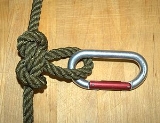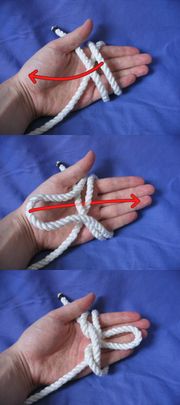
Alpine butterfly knot
Encyclopedia
The alpine butterfly knot is a knot
used to form a fixed loop in the middle of a rope
. Tied in the bight, it can be made in a rope without access to either of the ends; this is a distinct advantage when working with long climbing
ropes. The butterfly loop is an excellent mid-line rigging knot, it is symmetrical and handles multi-directional loading well. In a climbing context it is also useful for traverse
lines, some anchors
, shortening rope slings
, and for isolating damaged sections of rope.
bulletin from what is now Iowa State University
. Burger called the knot a lineman's rider stating it was often used by "linemen and especially telephone men". The knot's security and ability to take strain in any direction are both discussed.
The knot's association with mountaineering
—and with butterflies—originates from a 1928 article in Alpine Journal
by C.E.I. Wright and J.E. Magowan. The authors claim to have developed the butterfly noose themselves while attempting to improve the selection of knots available to climbers. The name is "so styled on the basis of a more or less fanciful resemblance imagined in the form of the knot." In the second part of the article they express dissatisfaction regarding their earlier use of the word "noose", since the knot is non-collapsing, and refer to the knot as butterfly loop or simply butterfly. Wright and Magowan call the butterfly loop "new", along with several other of their knots, in the sense they were unable to identify any earlier record of them. However, they prudently added that it "might be rash to claim they have never been used before."
When Clifford Ashley covered the knot in 1944, calling it the lineman's loop, he attributed its first publication to J.M. Drew but made no specific reference as to the source of this claim. A 1912 article called "Some Knots and Splices" by Drew appears in the bibliography of The Ashley Book of Knots
. A 1913 reprint of this Drew article does not mention the butterfly knot.
 The butterfly loop has a high breaking strength and is regarded by mountaineers as one of the strongest knots to attach climbers to the middle of a rope, such that they have room to move around even when the main rope goes tight, and they can be supported in either direction from the main rope. The loop is typically attached to a climbing harness by carabiner
The butterfly loop has a high breaking strength and is regarded by mountaineers as one of the strongest knots to attach climbers to the middle of a rope, such that they have room to move around even when the main rope goes tight, and they can be supported in either direction from the main rope. The loop is typically attached to a climbing harness by carabiner
.
It can also be used to isolate a worn section of rope, where the knot is tied such that the worn section is isolated in the loop (which of course does not receive a carabiner nor bear any loads in this case). In fact, the knot can be tied as a bend
with the ends emerging where the loop would be. The loop portion is isolated when the other two legs are loaded.
Errors in tying the butterfly knot can produce a similar looking but inferior knot, the so-called "false butterfly", which is prone to slipping. However, some sources suggest this behavior can be exploited purposely for shock absorption. Wright and Magowan called this less secure loop knot the "half-hitch noose".
Knot
A knot is a method of fastening or securing linear material such as rope by tying or interweaving. It may consist of a length of one or several segments of rope, string, webbing, twine, strap, or even chain interwoven such that the line can bind to itself or to some other object—the "load"...
used to form a fixed loop in the middle of a rope
Rope
A rope is a length of fibres, twisted or braided together to improve strength for pulling and connecting. It has tensile strength but is too flexible to provide compressive strength...
. Tied in the bight, it can be made in a rope without access to either of the ends; this is a distinct advantage when working with long climbing
Climbing
Climbing is the activity of using one's hands and feet to ascend a steep object. It is done both for recreation and professionally, as part of activities such as maintenance of a structure, or military operations.Climbing activities include:* Bouldering: Ascending boulders or small...
ropes. The butterfly loop is an excellent mid-line rigging knot, it is symmetrical and handles multi-directional loading well. In a climbing context it is also useful for traverse
Traverse (climbing)
A traverse is a lateral move or route when climbing; going mainly sideways rather than up or down. Traversing a climbing wall is a good warm-up exercise....
lines, some anchors
Anchor (climbing)
In rock climbing, an anchor can be any way of attaching the climber, the rope, or a load to rock, ice, steep dirt, or a building by either permanent or temporary means...
, shortening rope slings
Sling (climbing equipment)
A sling or runner is an item of climbing equipment consisting of a tied or sewn loop of webbing that can be wrapped around sections of rock, hitched to other pieces of equipment or tied directly to a tensioned line using a prusik knot; for anchor extension , equalization, or climbing the...
, and for isolating damaged sections of rope.
History
The earliest known presentation of the knot was in A.A. Burger's 1914 work Rope and Its Uses, included in an agricultural extensionAgricultural extension
Agricultural extension was once known as the application of scientific research and new knowledge to agricultural practices through farmer education...
bulletin from what is now Iowa State University
Iowa State University
Iowa State University of Science and Technology, more commonly known as Iowa State University , is a public land-grant and space-grant research university located in Ames, Iowa, United States. Iowa State has produced astronauts, scientists, and Nobel and Pulitzer Prize winners, along with a host of...
. Burger called the knot a lineman's rider stating it was often used by "linemen and especially telephone men". The knot's security and ability to take strain in any direction are both discussed.
The knot's association with mountaineering
Mountaineering
Mountaineering or mountain climbing is the sport, hobby or profession of hiking, skiing, and climbing mountains. While mountaineering began as attempts to reach the highest point of unclimbed mountains it has branched into specialisations that address different aspects of the mountain and consists...
—and with butterflies—originates from a 1928 article in Alpine Journal
Alpine Journal
The Alpine Journal is the yearly publication of the Alpine Club of London. It is the oldest mountaineering journal in the world.-History:The journal was first published on 2 March 1863 by the publishing house of Longmans in London, with Hereford Brooke George as its first editor...
by C.E.I. Wright and J.E. Magowan. The authors claim to have developed the butterfly noose themselves while attempting to improve the selection of knots available to climbers. The name is "so styled on the basis of a more or less fanciful resemblance imagined in the form of the knot." In the second part of the article they express dissatisfaction regarding their earlier use of the word "noose", since the knot is non-collapsing, and refer to the knot as butterfly loop or simply butterfly. Wright and Magowan call the butterfly loop "new", along with several other of their knots, in the sense they were unable to identify any earlier record of them. However, they prudently added that it "might be rash to claim they have never been used before."
When Clifford Ashley covered the knot in 1944, calling it the lineman's loop, he attributed its first publication to J.M. Drew but made no specific reference as to the source of this claim. A 1912 article called "Some Knots and Splices" by Drew appears in the bibliography of The Ashley Book of Knots
The Ashley Book of Knots
The Ashley Book of Knots is an encyclopedia of knots first published in 1944 by Clifford Warren Ashley. The culmination of over 11 years of work, it contains some 7000 illustrations and more than 3854 entries covering over 2000 different knots. The entries include instructions, uses, and for some...
. A 1913 reprint of this Drew article does not mention the butterfly knot.
Use

Carabiner
A carabiner or karabiner is a metal loop with a sprung or screwed gate that is used to quickly and reversibly connect components in safety-critical systems. The word comes from "Karabinerhaken", meaning "hook for a carbine" in German.-Use:...
.
It can also be used to isolate a worn section of rope, where the knot is tied such that the worn section is isolated in the loop (which of course does not receive a carabiner nor bear any loads in this case). In fact, the knot can be tied as a bend
Alpine butterfly bend
The butterfly bend is a type of knot. It is the analogous bend form of the alpine butterfly knot in that it is the butterfly loop with the loop cut. It is very similar to the hunter's bend.-External links:*...
with the ends emerging where the loop would be. The loop portion is isolated when the other two legs are loaded.
Errors in tying the butterfly knot can produce a similar looking but inferior knot, the so-called "false butterfly", which is prone to slipping. However, some sources suggest this behavior can be exploited purposely for shock absorption. Wright and Magowan called this less secure loop knot the "half-hitch noose".
Advantages
- Forms stable, secure loop after initial setting
- Allows for the knot to be loaded three ways; by each end of the main line and the loop
- Relatively easy to untie after loading (more difficult if wet)
- Size of loop can be adjusted more easily than with bulkier or more complex loop knots
- Easy to inspect
- Can be easily tied with gloves on (useful for cold weather alpine climbing)
Disadvantages
- Difficult to tie around a solid ring or similar object, as when a rethreaded figure eight is needed
- Difficult to tie one-handed
- Improper tying can result in similar looking but inferior "false butterfly" knot
- Works best with softer ropes

